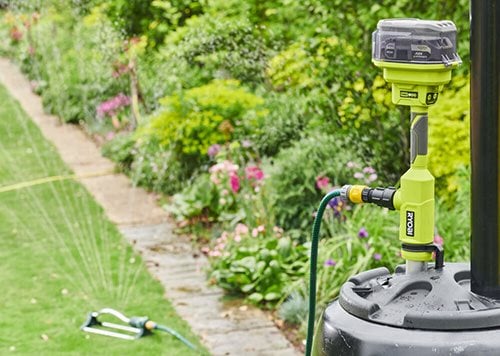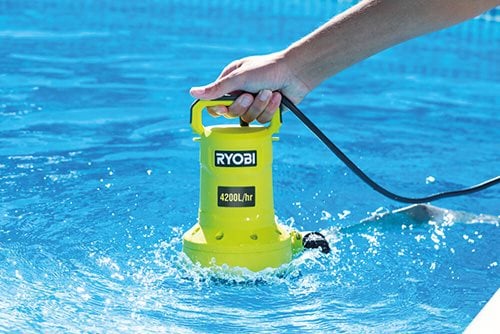What Are Pumps?
RYOBI welcomes you to the wonderful world of pumps. So, what are they?
Water pumps are like the Swiss Army knives of problem-solving tools. They can tackle all sorts of issues and just make your life a whole lot easier. They're basically your go-to heroes for moving water from one spot (think basement) to another (like, outside).
Whether you want to utilise harvested water with a sprinkler to keep your lawn lush, lower water levels in ponds to conduct maintenance, or even take on larger DIY jobs like empty heater system – RYOBI have you covered.
How can we simplify pumps?
Think of a water pump like a superhero that can move water. The flow rate is how much water the superhero can carry in a certain time, like how many buckets of water they can move in a minute.
Now, imagine the delivery height as how high the superhero can lift those buckets. If they need to lift the buckets really high, they might not be able to carry as many in the same time. But if they don't have to lift them too high, they can carry more buckets quickly.
In short: If the superhero needs to lift water really high, they might not be able to move as much water fast. If they don't have to lift it very high, they can move more water quickly. It's a bit like how you might carry fewer books when climbing stairs, but you can carry more when walking on a flat path.
.jpg?v=1718032915000)
How do I know what pump to use?
With Ryobi’s ever expanding pump range, it may become confusing to decide what you need for your task.
Why pick transfer pump?
- No Immersion Required: Transfer pumps are designed to be used outside of the water source. If you’re washing machine has leaked underneath your kitchen cabinets, a transfer pump is great. Allowing you to reach underneath into tight spaces.
- Traditionally have higher delivery heights: Transfer pumps can handle pumping water to higher elevations compared to submersible pumps. If you need to move water to a significant height, a transfer pump might have the required power and performance.
_1.jpg?v=1718035658000)
Why pick a stick pump?
- Great for evacuating water out of trenches. Maybe you've started a DIY pergola project but it's rained heavy overnight. Drop this in for simple & fast water removal.
- Optimised for traditional 220l rain barrels. This unit can live in your water barrel. Harvest water & utlise it around the garden!

Why pick a submersible pump?
- Fastest flow of water to get the job done fast. Empty a bathtub in less that 1 minute. No problem
- Reach new depths. Plunge your pump up to 7m deep, you could empty a well!

Why do I need a water pump?
Everyday consumers can find a variety of practical uses for cordless water pumps due to their convenience, versatility, and portability. Some common applications include:
Irrigation
|
Household Chores, Cleaning & Maintenance
|
Aquariums & Animal care
|
| |
|
|
- Cordless water pumps are handy for transferring water from buckets, containers, or rain barrels to water plants, lawns, and gardens.
- They make watering hassle-free, especially in areas without easy access to water sources. Small irrigation systems.
|
- Cordless pumps can assist in tasks like emptying clogged sinks, clearing water from flooded basements, or draining water heaters for maintenance.
- They can help with cleaning tasks like removing water from flat roofs, decks, or outdoor play areas after rain.
|
- Cordless pumps can be used to transfer water to pet bowls, fish tanks, or outdoor animal troughs.
- Aquarium Maintenance: Transfer pumps can help with water changes and cleaning in aquariums, siphoning out dirty water or refilling tanks.
|
| |
|
|
Outdoor Water Features & Ponds
|
Boating, Caravans & Camping
|
Emergency Preparedness
|
| |
|
|
| |
- Lowering water levels before heavy rainfall is a great application for a cordless pump. Quick set-up to complete the job.
- For Smaller water features, evacuate all the water without the need of finding power.
|
- Cordless pumps are useful for transferring water to boats, campers, or motorhomes. They can also assist in draining water from boats after rainy days.
|
- Having a cordless water pump as part of an emergency kit is beneficial during power outages or natural disasters. It can be used to transfer water from one container to another or to address minor flooding.
|
Benefits of cordless water pumps
A cordless water pump is a portable device designed to move water from one location to another without the need for a power cord or electrical connection. ONE+ has you covered, allowing for greater mobility and flexibility in various applications, such as transferring water from one container to another, draining small pools, or handling minor flooding situations. The cordless design eliminates the restrictions of power cords and outlets, making these pumps convenient and easy to use in different settings.
.jpg?v=1718033840000)
Advantages of cordless water pumps
Cordless water pumps offer several advantages that make them a valuable tool for various applications:
- Portability and Mobility: Cordless water pumps are highly portable, allowing you to move them easily from one location to another without being tethered to a power outlet. This mobility is particularly useful for tasks in remote areas or where access to electricity is limited. Such as an allotment or wildlife area.
- Convenience: With no power cord to manage, cordless water pumps offer a hassle-free and convenient experience. You can quickly set up and operate the pump without the need for extension cords or nearby outlets.
- Versatility: These pumps can be used for a wide range of applications, including transferring water from containers, draining small areas, emptying pools, or even handling emergency situations like minor flooding.
- Quiet Operation: Cordless water pumps are often designed to operate quietly, making them suitable for environments where noise levels need to be minimized.
- Ease of Use: Most cordless water pumps feature simple controls and ergonomic designs, making them easy to start, operate, and maintain.
- Reduced Environmental Impact: Unlike gas-powered pumps, cordless pumps do not emit exhaust fumes or contribute to air pollution. This makes them a more environmentally friendly option, especially for indoor or enclosed spaces.
- Lower Maintenance: Cordless pumps typically have fewer maintenance requirements compared to gas-powered pumps. There's no need to worry about engine oil changes, spark plugs, or air filters.
- Safety: Cordless pumps eliminate the risks associated with gasoline storage and handling. There's no need to worry about flammable fuels or exhaust emissions.
- Flexibility: Some cordless water pumps come with adjustable flow rates and settings, allowing you to tailor the pump's performance to specific tasks.
- Emergency Preparedness: Cordless water pumps can be valuable tools to have in emergency kits or disaster preparedness plans, providing a reliable means of water transfer during power outages or other crises.
Overall, cordless water pumps offer the convenience of cord-free operation and versatility. They can be a practical solution for various water-moving needs, both indoors and outdoors.